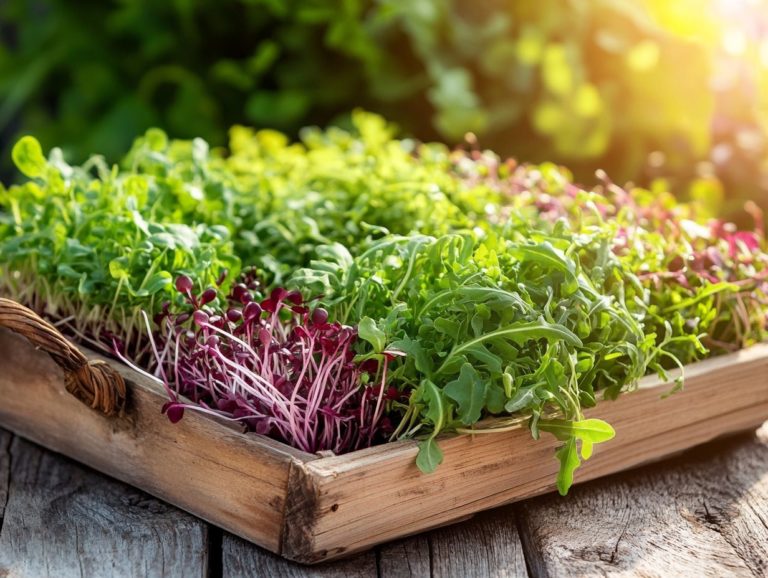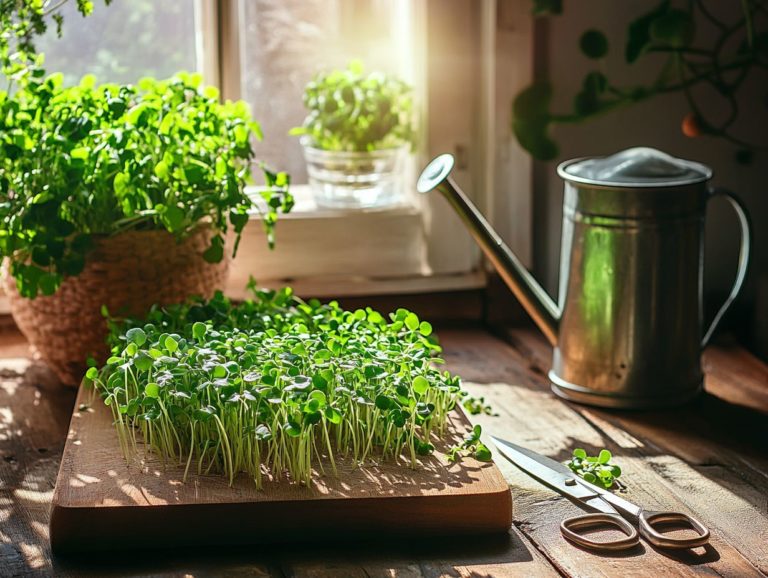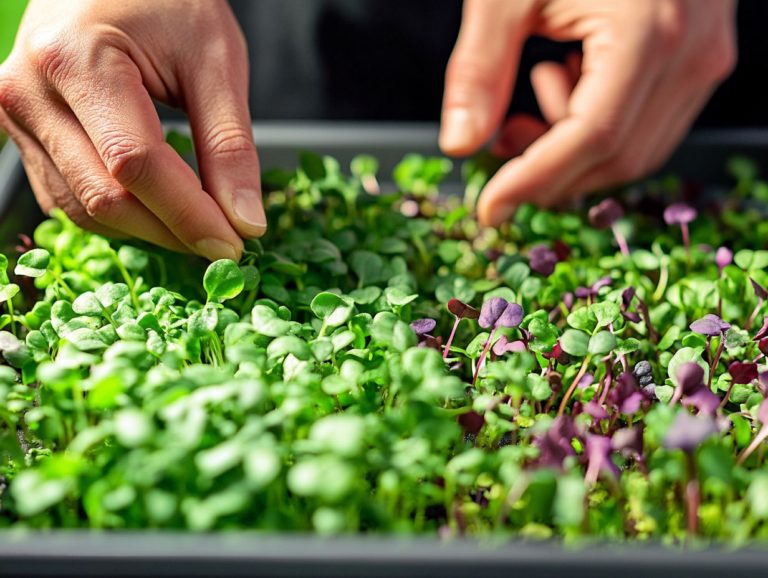5 Microgreen Storage Hacks You Need to Know
Microgreens are more than just a fashionable garnish; they boast an impressive array of flavors and nutrients. They make an exceptional addition to your meals and are vital for preserving freshness and vitality. Proper storage methods are essential.
Explore five indispensable storage hacks that will extend the life of your microgreens. We also provide answers to frequently asked questions about their storage, safety, and creative culinary usage tips for incorporating them into your diet. Are you ready to elevate your culinary experience?
Contents
- Key Takeaways:
- 1. Use Airtight Containers
- 2. Keep Them in the Refrigerator
- 3. Rinse and Dry Before Storage
- 4. Store in a cool and dark place
- 5. Use a damp paper towel
- What Are Microgreens and Why Are They Popular?
- What Are the Best Types of Containers for Storing Microgreens?
- What Is the Ideal Temperature for Storing Microgreens?
- How Can One Tell If Microgreens Have Gone Bad?
- Are There Any Other Ways to Extend the Shelf Life of Microgreens?
- Can Microgreens Be Frozen for Storage?
- What Are Some Common Mistakes When Storing Microgreens?
- How Can One Incorporate Microgreens into Their Diet?
- Are There Any Safety Concerns When Storing Microgreens?
- How Can One Grow Their Own Microgreens for Fresh Storage?
- What Are Some Creative Ways to Use Stored Microgreens in Meals?
- Frequently Asked Questions
Key Takeaways:
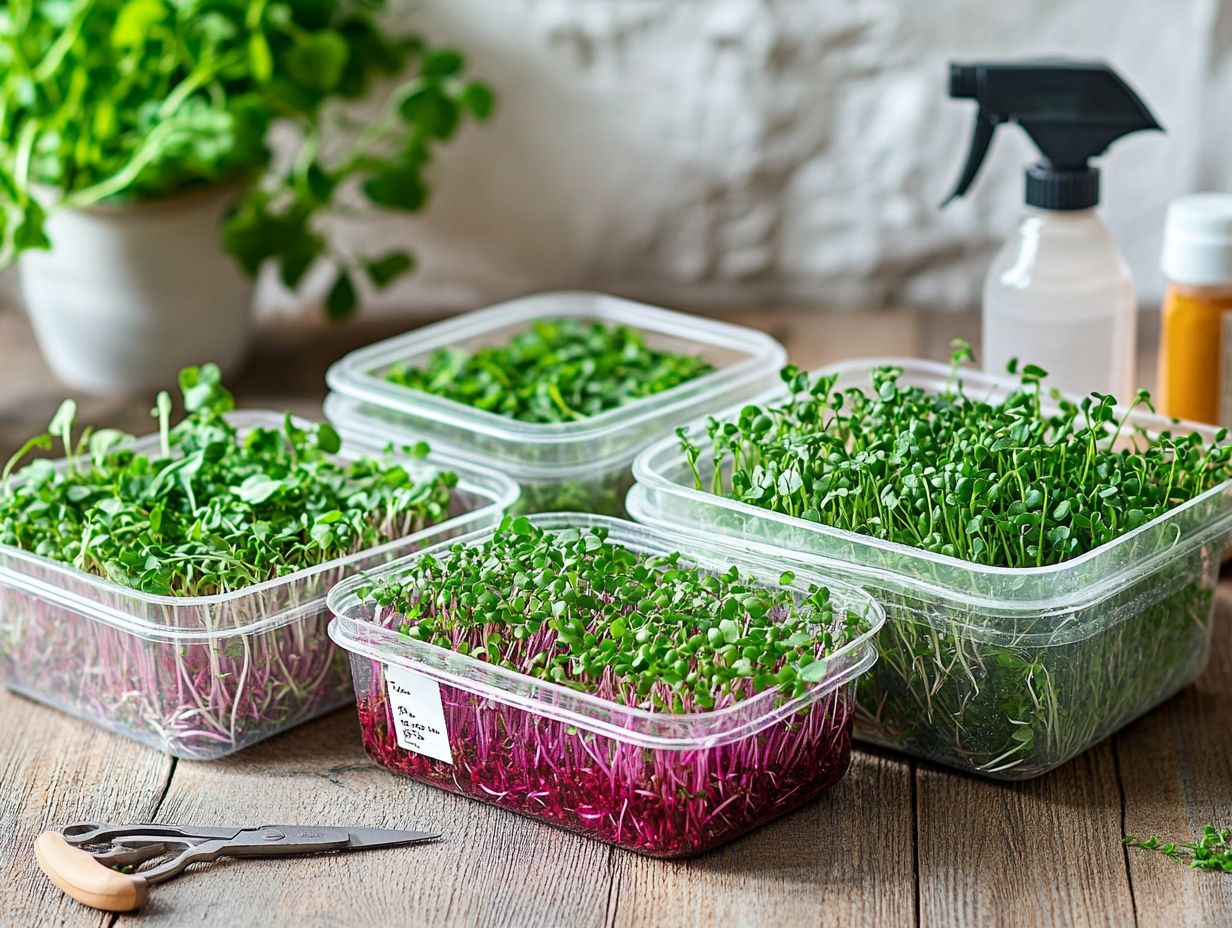
- Use airtight containers to keep microgreens fresh and prevent them from wilting.
- Store microgreens in the refrigerator at a temperature of 36-40 degrees Fahrenheit to maintain their freshness.
- Before storing, rinse and dry microgreens to remove excess moisture and prevent mold growth.
1. Use Airtight Containers
To maintain the harvest freshness and nutrient value of your microgreens, it s essential to store them in airtight containers that effectively manage moisture and airflow. This ensures their longevity and preserves their distinct flavors, allowing you to unleash your creativity in the kitchen.
Choosing the right type of container significantly impacts their shelf life. Clamshell containers are particularly advantageous due to their transparent design, providing easy visibility of your microgreens while allowing some ventilation. If you’re leaning towards sustainability, biodegradable bags can be an eco-friendly choice that promotes freshness without compromising your environmental values.
When selecting your containers, opt for those with vents or breathable materials to help regulate humidity. Proper airflow prevents condensation buildup, which can lead to spoilage. By paying close attention to these factors, you can enjoy crisp, nutrient-rich microgreens for a longer period, enhancing your meals without compromise.
2. Keep Them in the Refrigerator
Storing microgreens in the refrigerator is essential for preserving their freshness and slowing down spoilage. This also helps minimize their exposure to ethylene gas, a gas released by fruits that speeds up ripening, emitted by other fruits and vegetables in your fridge.
To ensure maximum longevity and crispness, maintain the temperature between 32 F and 40 F. It’s important to keep your microgreens tightly wrapped or in an airtight container to prevent moisture loss, which can lead to wilting. For more tips, check out this guide on how to prevent spoilage in microgreens.
Be mindful not to place them near ethylene-producing fruits like apples or bananas, as this gas hastens ripening and can negatively affect their flavor and nutritional content. By following these storage guidelines, you can maintain the delicate balance of nutrients and taste that makes microgreens a prized addition to salads, sandwiches, and a variety of dishes.
3. Rinse and Dry Before Storage
Before storing your microgreens, rinse and dry them thoroughly. Excess moisture can risk both their quality and flavor diversity.
To ensure your microgreens are impeccably cleaned, consider using tools like a Pump Sprayer or Mini Washer. These tools save you time and deliver a gentle rinse that preserves the integrity of those delicate leaves.
After rinsing, don t overlook the drying process; a salad spinner or simply patting them down with paper towels will do the trick. Ensuring the greens are completely dry before storage is critical, as any trapped moisture can drastically shorten their shelf life.
Think about spreading them out in a single layer on a clean towel or a drying rack. This maximizes air circulation, effectively preventing any dampness that could lead to spoilage.
4. Store in a cool and dark place
To maximize preservation, you should store microgreens in a cool, dark place. Exposure to light and heat can quickly diminish their nutrient value and alter their flavor profile.
Choosing the right storage environment is key. It helps maintain the quality of these delicate greens.
A refrigerator set to a slightly higher temperature can work wonders, keeping your microgreens crisp while preventing wilting.
Consider using opaque containers to block light and further enhance their longevity. An environment with minimal temperature fluctuations is also beneficial. Consistent conditions help reduce the risk of spoilage.
Utilizing the crisper drawer is a smart move; it provides the perfect balance of humidity and coolness.
Keeping your microgreens in a dark, cool space preserves their nutrients and robust flavors. This makes them a favorite in many kitchens.
5. Use a damp paper towel
Using a damp paper towel in your storage container is crucial for keeping moisture levels just right. Act now to keep your microgreens fresh!
This powerful technique creates a balanced environment in airtight containers. It absorbs excess humidity and keeps the greens from drying out.
By controlling moisture levels, you keep your microgreens vibrant and preserve their flavors, enhancing your overall culinary experience.
If you’re looking to elevate your preservation techniques, consider exploring alternative methods such as using infused oils. This approach can impart unique flavors while extending shelf life.
Combining these techniques enables you to enjoy your microgreens at their absolute best, free from any unwanted limpness or loss of taste.
What Are Microgreens and Why Are They Popular?
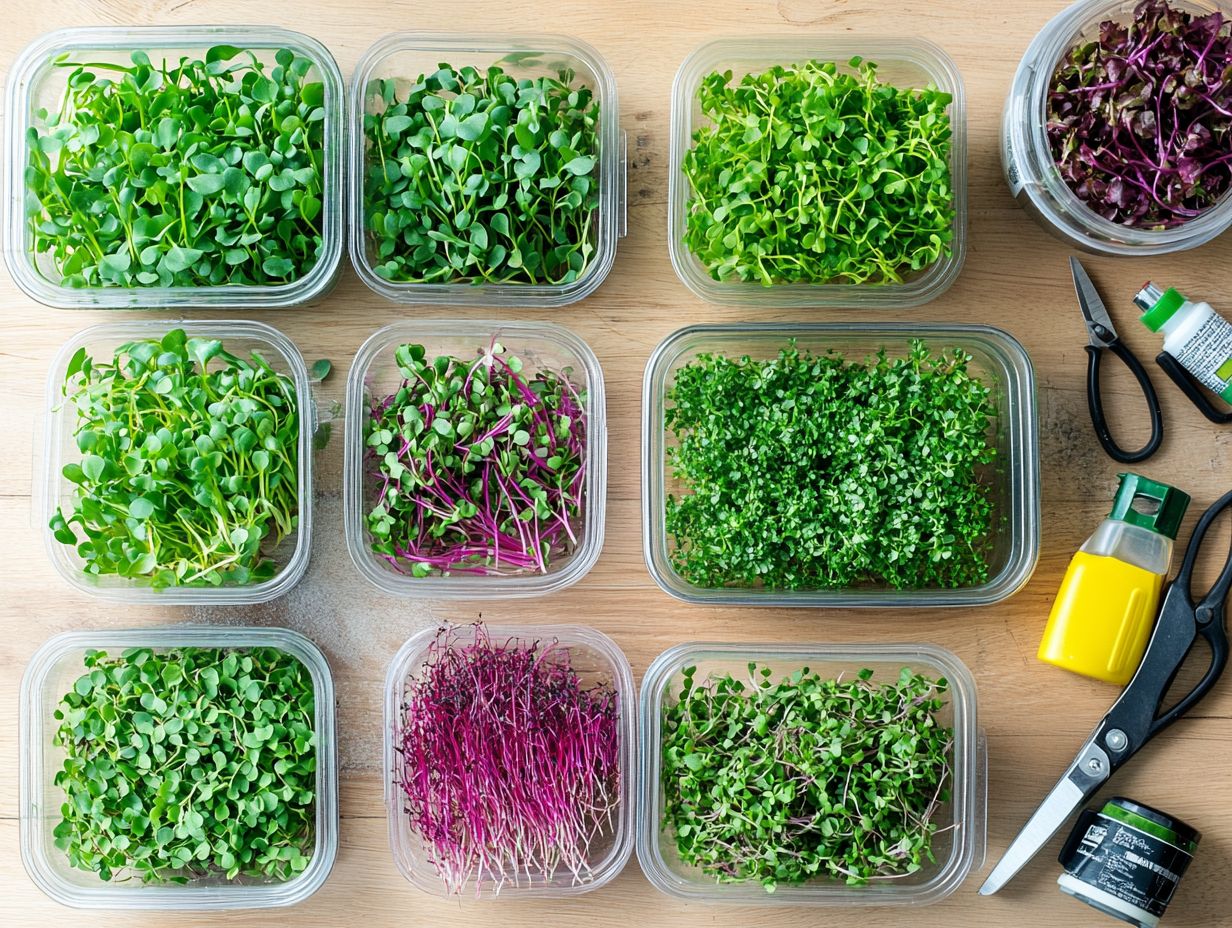
Microgreens are young plants bursting with nutrients, ready for harvest right after their first true leaves appear. They’re adored for their vibrant colors, diverse flavors, and impressive health benefits, making them a fantastic choice for home growing.
These petite greens cover a wide range of species, from arugula and radish to basil and kale. Each is brimming with an impressive array of vitamins, minerals, and antioxidants.
The growing health consciousness among consumers has propelled their popularity in both gourmet kitchens and everyday home cooking.
Elevate your meals by adding microgreens to dishes like pesto. They enhance texture and flavor, boosting nutritional value.
Their versatility allows you to complement salads, sandwiches, and even use them as garnishes, making microgreens a multifaceted ingredient that elevates modern cuisine to new heights.
What Are the Best Types of Containers for Storing Microgreens?
Choosing the right storage containers for your microgreens is vital to preserving their freshness and flavor. Options like clamshell containers and biodegradable bags are effective choices you should consider.
Clamshell containers offer a sturdy and ventilated environment that effectively maintains moisture levels while reducing the risk of spoilage. Their transparent design allows you to easily see the quality of the microgreens inside, making it simple to assess their freshness at a glance.
Alternatively, biodegradable bags present an eco-friendly option that provides flexibility and breathability, helping to keep your greens fresh while being gentle on the planet.
This comparison illustrates how choosing the right container is crucial in extending the shelf life and enhancing the overall quality of your microgreens.
What Is the Ideal Temperature for Storing Microgreens?
The ideal temperature for storing microgreens falls between 32 F and 40 F. Proper refrigeration is important to keep their freshness and extend shelf life.
It’s crucial to maintain this specific temperature range. Even minor fluctuations can lead to wilting, nutrient degradation, and faster spoilage of these delicate crops. If microgreens stray outside this optimal zone, they risk losing their vibrant colors and essential flavors, making them less appealing, particularly in culinary applications.
To ensure your refrigeration practices are effective, consider the following preservation tips:
- Check fridge temperatures regularly with a reliable thermometer.
- Avoid placing microgreens near the back of the fridge, where it tends to be colder.
- Store them in airtight containers to minimize exposure to moisture and odors.
In commercial settings, regularly checking temperatures and investing in high-quality refrigeration units can significantly help maintain the desired conditions. For optimal freshness, refer to this guide on how to store microgreens.
How Can One Tell If Microgreens Have Gone Bad?
Spotting spoilage in your microgreens is key! Keep an eye out for wilted leaves, off odors, and discoloration these are telltale signs that your greens might have gone bad.
If you notice a slimy texture on the stems or leaves, it s likely due to excessive moisture or bacterial growth. A sour or rotten smell is a clear warning signal that you shouldn’t ignore. Consuming spoiled microgreens can expose you to health risks, including foodborne illnesses caused by harmful bacteria like E. coli or Salmonella.
To minimize these risks, always check the freshness of your microgreens first! When it’s time to dispose of any spoiled greens, use a sealed plastic bag to contain odors and keep pests at bay. If the microgreens are uncontaminated, composting is a fantastic, eco-friendly way to handle organic waste. For optimal freshness, refer to the best methods for storing microgreens.
Are There Any Other Ways to Extend the Shelf Life of Microgreens?
Besides mastering proper storage techniques, you can explore several effective methods to extend the shelf life of your microgreens, including freezing options and using infused oils for preservation.
These approaches not only preserve their vibrant flavors and nutritional benefits but also simplify the process of incorporating these tiny greens into a variety of dishes year-round. Freezing microgreens is a straightforward way to maintain their freshness. By briefly blanching them (briefly boiling the greens before cooling them), you can lock in those delightful flavors and essential nutrients. For more detailed instructions, check out these tips for washing and storing microgreens. Alternatively, infusing oils with microgreens creates a flavorful condiment that captures the essence of the greens while elevating your meals.
Each of these techniques provides an innovative way to keep your microgreens at their peak, ensuring that you can enjoy their health benefits long after the initial harvest.
Can Microgreens Be Frozen for Storage?
Yes, you can freeze microgreens for storage, and when done correctly, this method beautifully preserves their nutrient value while offering you convenient access for future culinary adventures.
To achieve the best results, it’s crucial to prepare your microgreens before freezing. Start by gently washing them to remove any dirt or debris, and then let them dry completely to prevent ice crystals from forming. For more tips on keeping them fresh, check out this guide on how to extend the shelf life of microgreens.
Next, consider blanching the greens briefly in boiling water before plunging them into ice water. This technique helps maintain their color and texture. Once drained, place them in airtight containers or freezer bags, ensuring you remove as much air as possible.
While freezing may soften their texture slightly and alter their fresh flavor, don t underestimate the potential of frozen microgreens they can still elevate a variety of recipes.
They serve wonderfully as toppings for soups, blend seamlessly into smoothies, or add a nutritious kick when saut ed in stir-fries, all while retaining a burst of nutrients even in their frozen state.
Start storing your microgreens like a pro today!
What Are Some Common Mistakes When Storing Microgreens?
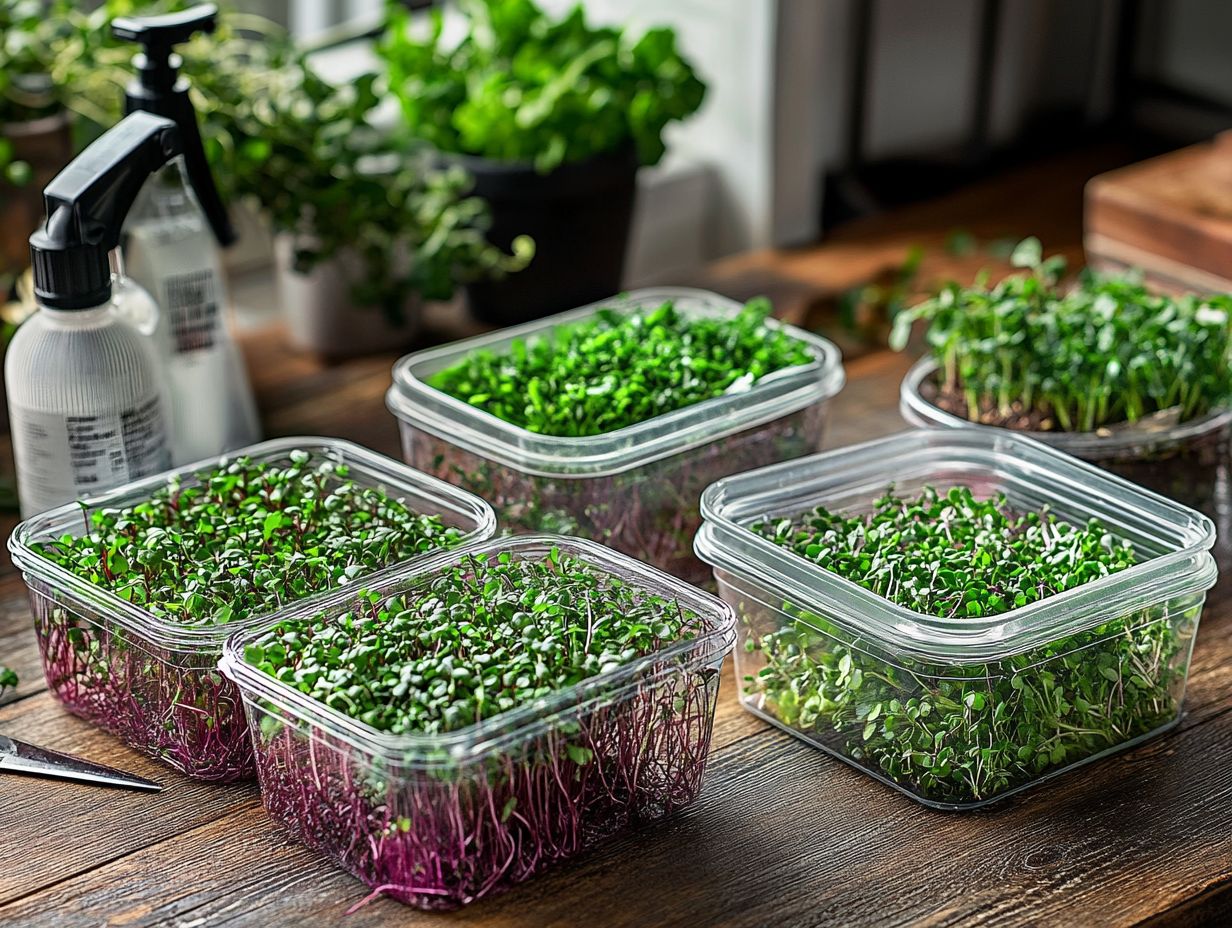
Common mistakes in storing microgreens can quickly lead to a loss of freshness and flavor. This includes issues like improper moisture management, using the wrong containers, and neglecting temperature control.
These mistakes can result in wilting, mold growth, and a decrease in nutritional value. Ultimately, they diminish the quality of the microgreens you wish to enjoy. It s vital to manage humidity levels; for example, keeping your microgreens too wet or too dry can jeopardize their crispness and vibrant color.
Airtight containers are essential, but using them requires finesse to avoid trapping excess moisture. Ensuring that your microgreens are stored at optimal temperatures not too cold or hot can make all the difference in extending their freshness.
Following these best practices can significantly enhance the longevity and taste of your microgreens.
How Can One Incorporate Microgreens into Their Diet?
Incorporating microgreens into your diet is easy and highly rewarding! You ll be amazed at the difference they make. You have a myriad of options at your fingertips whether you re adding them to salads, sandwiches, blending them into smoothies, or even using them as health supplements.
These tiny greens are bursting with nutrients and flavors, capable of elevating your everyday meals in delightful and unexpected ways. Imagine sprinkling radish microgreens on your avocado toast for a zesty kick or tossing a handful of pea shoots into stir-fries for that perfect blend of texture and sweetness. Their impressive vitamin content supports your immune function, while their bold flavors can transform a mundane dish into a gourmet experience.
Don t shy away from experimenting with diverse varieties like basil, cilantro, or amaranth. Each brings its own unique flair, inviting your culinary creativity to flourish and offering a nutritional boost to every plate you serve. Why not start today? Add fresh microgreens to your meals and taste the difference!
Are There Any Safety Concerns When Storing Microgreens?
While microgreens are generally safe to enjoy, there are valid safety concerns regarding spoilage and contamination that can pose health risks if not managed properly during storage.
To ensure these vibrant greens remain safe for your consumption, it’s crucial to follow best practices for handling and storing them. Keep your microgreens in a cool, dry place preferably in the refrigerator to slow down their natural deterioration. Remember to store them in a breathable container, as excessive moisture can lead to mold growth. For more detailed information, check out this guide on how to store different microgreen varieties.
Before you dive in, wash your hands and surfaces thoroughly to minimize any chance of cross-contamination. Using airtight bags or containers can further safeguard against spoilage. Check for any signs of wilting or discoloration to ensure you enjoy only the freshest produce.
By staying vigilant about these practices, you can significantly reduce any health risks associated with microgreens.
How Can One Grow Their Own Microgreens for Fresh Storage?
Growing your own microgreens at home is not just an enjoyable endeavor; it s an enriching experience that grants you easy access to fresh produce while delivering impressive health benefits thanks to their nutrient-packed profile. This delightful journey nurtures not only your green thumb but also fosters a deeper connection to the food you consume.
To embark on this adventure, start by selecting a variety of seeds that align with your culinary preferences. This ensures a vibrant array of flavors and nutrients. Next, establishing an effective setup with grow lights special lights that help plants grow indoors by mimicking sunlight is essential for healthy growth, even in compact indoor spaces.
Mastering optimal watering techniques like bottom watering to prevent leaf rot can significantly boost your success with these tiny greens. The benefits of nurturing a microgreens garden extend well beyond personal consumption; they can transform ordinary dishes into culinary masterpieces with their vibrant colors and bold flavors, adding a touch of artistry to your everyday meals. To keep your microgreens fresh, check out storing microgreens tips for freshness.
What Are Some Creative Ways to Use Stored Microgreens in Meals?
Stored microgreens are your secret weapon in the kitchen. They add delightful flavors to your meals.
These vibrant greens are packed with essential nutrients. They can transform simple ingredients into something extraordinary.
Consider radish microgreens. They add a peppery kick to avocado toast, contrasting beautifully with the creamy avocado.
Basil microgreens can enhance your homemade pesto. This refreshing twist is perfect over grilled vegetables or mixed with pasta.
Sprinkle microgreens on seafood or blend them into smoothies. Their unique flavors inspire culinary creativity.
Frequently Asked Questions
What are microgreens and why are they popular?
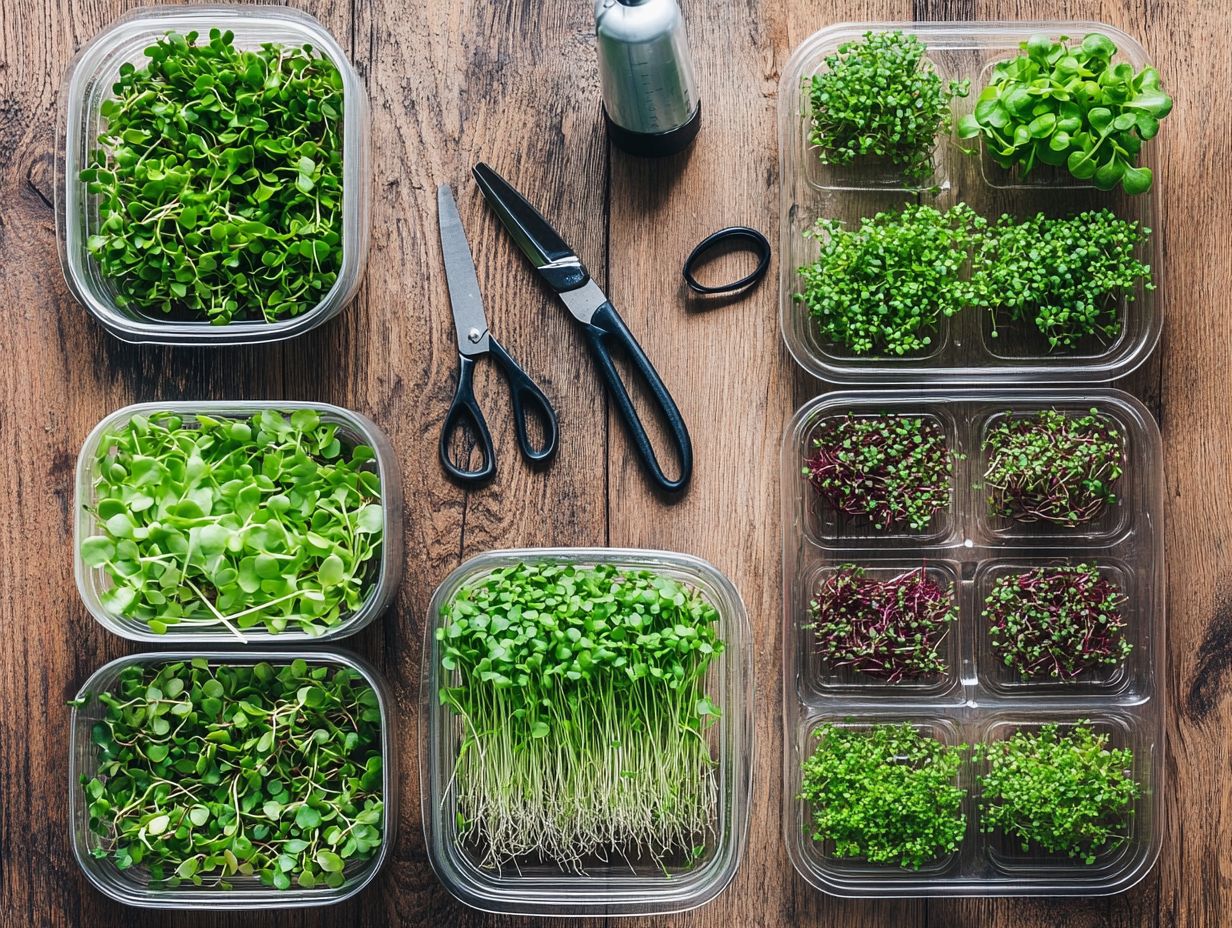
Microgreens are young, edible greens packed with flavor and nutrients. They are popular for their intense taste and versatility in cooking.
Why is proper storage important for microgreens?
Proper storage keeps microgreens fresh and flavorful. Bad storage can lead to wilting and sogginess.
What are the top 5 microgreen storage hacks?
1. Use airtight containers to keep out moisture.
2. Store in the fridge at 35-40 F.
3. Use damp paper towels to maintain hydration.
4. Keep out of direct sunlight to avoid wilting.
5. Label and date your containers to track freshness.
Can I freeze microgreens for storage?
Yes, you can freeze microgreens, but they may lose some texture and flavor. Use them fresh when possible!
How long can microgreens be stored for?
Fresh microgreens last up to 5 days in the fridge. Frozen ones can last several months.
Are there any special tips for storing specific types of microgreens?
Store cilantro and parsley with their stems in water for airflow. Radish and broccoli microgreens should be wrapped in damp paper towels. Always check individual storage needs for the best results.

